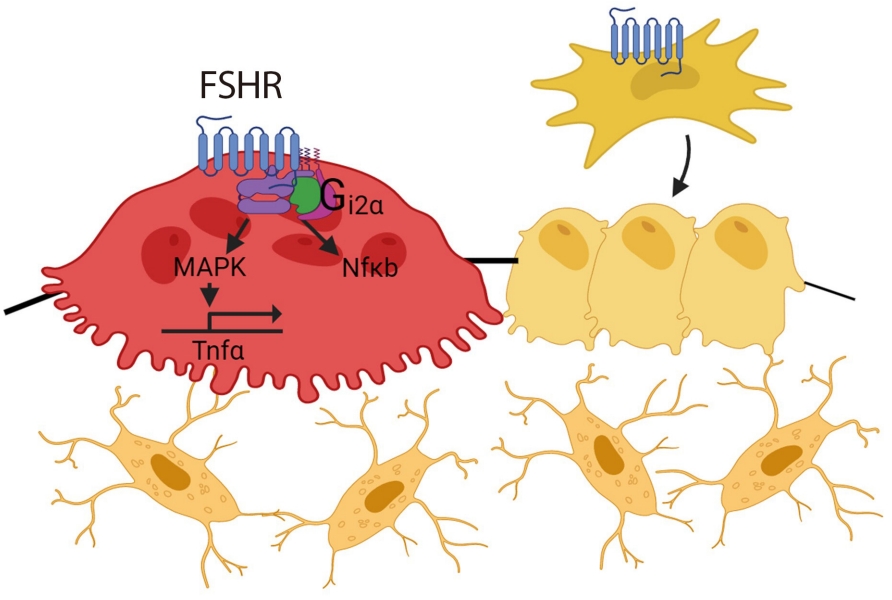Search
- Page Path
- HOME > Search
Review Article
- Hypothalamus and Pituitary Gland
- Independent Skeletal Actions of Pituitary Hormones
- Se-Min Kim, Farhath Sultana, Funda Korkmaz, Daria Lizneva, Tony Yuen, Mone Zaidi
- Endocrinol Metab. 2022;37(5):719-731. Published online September 28, 2022
- DOI: https://doi.org/10.3803/EnM.2022.1573

- 3,738 View
- 236 Download
- 4 Web of Science
- 4 Crossref
-
 Abstract
Abstract
 PDF
PDF PubReader
PubReader  ePub
ePub - Over the past years, pituitary hormones and their receptors have been shown to have non-traditional actions that allow them to bypass the hypothalamus-pituitary-effector glands axis. Bone cells—osteoblasts and osteoclasts—express receptors for growth hormone, follicle stimulating hormone (FSH), thyroid stimulating hormone (TSH), adrenocorticotrophic hormone (ACTH), prolactin, oxytocin, and vasopressin. Independent skeletal actions of pituitary hormones on bone have been studied using genetically modified mice with haploinsufficiency and by activating or inactivating the receptors pharmacologically, without altering systemic effector hormone levels. On another front, the discovery of a TSH variant (TSH-βv) in immune cells in the bone marrow and skeletal action of FSHβ through tumor necrosis factor α provides new insights underscoring the integrated physiology of bone-immune-endocrine axis. Here we discuss the interaction of each pituitary hormone with bone and the potential it holds in understanding bone physiology and as a therapeutic target.
-
Citations
Citations to this article as recorded by- New tools for bone health assessment in secreting pituitary adenomas
Meliha Melin Uygur, Stefano Frara, Luigi di Filippo, Andrea Giustina
Trends in Endocrinology & Metabolism.2023; 34(4): 231. CrossRef - A Causality between Thyroid Function and Bone Mineral Density in Childhood: Abnormal Thyrotropin May Be Another Pediatric Predictor of Bone Fragility
Dongjin Lee, Moon Ahn
Metabolites.2023; 13(3): 372. CrossRef - The mechanism of oxytocin and its receptors in regulating cells in bone metabolism
Liu Feixiang, Feng Yanchen, Li Xiang, Zhang Yunke, Miao Jinxin, Wang Jianru, Lin Zixuan
Frontiers in Pharmacology.2023;[Epub] CrossRef - To investigate the mechanism of Yiwei Decoction in the treatment of premature ovarian insufficiency-related osteoporosis using transcriptomics, network pharmacology and molecular docking techniques
Weisen Fan, Yan Meng, Jing Zhang, Muzhen Li, Yingjie Zhang, Xintian Qu, Xin Xiu
Scientific Reports.2023;[Epub] CrossRef
- New tools for bone health assessment in secreting pituitary adenomas

Original Article
- Regulation of FSH Gene Expression and Release in Cultured Rat Anterior Pituitary Cells.
- Min Seok Cheon, Deok Bae Park, Yong Bin Park, Kyung Yoon Kam, Kyung Za Ryu
- J Korean Endocr Soc. 2000;15(2):179-189. Published online January 1, 2001
- 944 View
- 17 Download
-
 Abstract
Abstract
 PDF
PDF - BACKGROUND
FSH is a heterodimeric glycoprotein and is composed of alpha and beta subunits. alpha subunit is common to FSH and LH, while an unique beta subunit determines the biological specificity of each hormone. The synthesis of beta subunit is the primary rate-limiting step in the synthesis of each hormone. Although FSH plays a pivotal role in folliculogenesis and ovulation, very little studies have been performed on the regulation of FSH beta gene expression. Therefore, the present study attempted to examine the effect of GnRH or activin on the expression of FSH beta mRNA as well as FSH release and signaling pathway involved in their actions. METHODS: The primary cultures of rat anterior pituitary were used for this study. To determine FSH beta mRNA levels, northern blotting method was used. The concentration of FSH in the culture medium was evaluated by using a specific radioimmunoassay for rat FSH. RESULTS: PMA, an activator of PKC, increased FSH beta mRNA levels and FSH release, whereas forskolin, an activator of adenylate cyclase, showed no effect. The application of GnRH augmented FSH release, but not FSH beta mRNA levels. However, the administration of activin increased FSH beta mRNA levels as well as FSH release. Staurosporine, an inhibitor of PKC, suppressed activin-induced increment of FSH beta mRNA levels and FSH release. CONCLUSION: The present study demonstrated that activin rather than GnRH is a major regulator for FSH beta mRNA expression, and suggest that PKC-dependent pathway is also involved in the action of activin on the expression of FSH beta mRNA and FSH release.


 KES
KES

 First
First Prev
Prev



